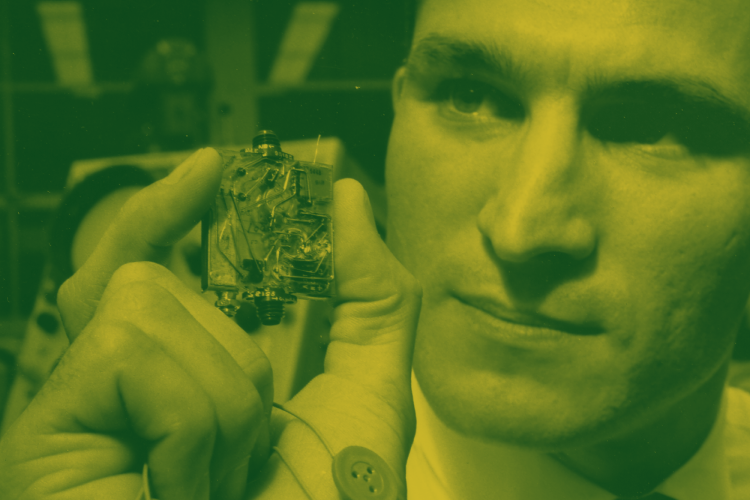Internal metric of space is influenced by geometry...
New Nature paper reveals that brain perceives distance differently depending on surroundings

Enhancing the brain’s capabilities is a central fantasy of our time—many dream of “unlocking” 100% of their brain to become super-productive and successful. However, research suggests that this desire is more likely to result in epilepsy and disruptions to the brain’s fundamental processes. So, how is the brain currently being stimulated, what are the dangers, and why are neurointerfaces an inevitable part of our future?
The 2011 movie “Limitless”, a hit among viewers and nominated for multiple awards, brought to the screen a highly persistent myth: that humans only use 10% of their brains and that raising this to 100% would exponentially increase human performance. The resilience of this myth comes from a kernel of truth. But, as always, it’s a matter of interpretation.
Attempting to “run” the brain at 100% won’t end well. In the cerebral cortex, only about 10% of neurons are inhibitory, but they perform a critical function—slowing down the activity of other neurons. This regulation is essential, as the brain needs to filter information and remove unnecessary signals, noises, and sensations. Without these inhibitory functions, a hyperactive system can quickly become dysfunctional, leading to conditions like epilepsy.
Physiologically, it’s also clear that we shouldn’t aim for 100% capacity, as all biological processes are built on homeostasis—a dynamic balance within the body. If one factor is artificially heightened, it disturbs this balance, with potentially harmful consequences.
Generally, brain enhancement involves introducing neurotransmitters like serotonin, dopamine, or glutamate to achieve specific effects. Dopamine, for example, is associated with increased learning ability. However, these chemicals can cause a “reverse U” effect, where brain functions initially improve but then collapse if dosages are too high. Additionally, a single neurotransmitter can affect multiple brain functions, and scientists are still unclear on the long-term effects, especially among young people.
Another approach to brain stimulation involves electroceuticals, where, instead of neurotransmitters, the brain is stimulated by electrodes that polarize neurons to either activate or inhibit specific areas. Though somewhat crude, this method can be effective.
Neurointerfaces are a relatively new method of extending brain function. Though still in the realm of imagination, they’re grounded in practical concepts and likely to be realized in the next two decades. The Economist even listed neuro interfaces among innovations, alongside space tourism, lab-grown meat, and an HIV vaccine.
A neurointerface is a device connected to the brain that reads information and processes it into valuable applications. Its primary focus is medical: a person with a paralyzed arm, for instance, could control a prosthetic limb directly through brain activity.
Beyond medical use, neurointerfaces aim to enhance brain function by combining human abilities with the power of computers, which process information and perform routine tasks far faster than humans. Currently, we interact with computers by pressing keys. Using natural skills like movement, touch, sight, and sound would be more efficient, but seamless integration with technology remains a challenge. Once this is achieved, brain enhancement via interfaces could transition from theory to tangible applications.
Simultaneously, a range of technologies collectively known as “artificial intelligence” is advancing. While biological and artificial neural networks differ, their processes share similarities. AI research has shed light on biological brain functions, with the possibility that one day, AI may assist humans via direct brain-computer interactions.
The dangers of neurointerfaces are evident. Take the well-known experiments by neuroscientist James Olds, who implanted electrodes in a rat’s brain. When the rat pressed a lever, it felt pleasure and continued pushing it, even for hours. In humans, there’s a comparable example: Parkinson’s patients with brain implants to alleviate symptoms. These implants, however, can stimulate areas close to those responsible for motivation and pleasure, occasionally making patients happier than usual. This accidental finding underscores the need to understand the potential effects of brain stimulation thoroughly.
Current research in neurointerfaces focuses on specific brain areas, examining their functions and attempting to extend them. For instance, experiments on the visual cortex involve electrodes that, when stimulated, cause the subject to see a flash of light (a “phosphene”) even in the dark. So far, it’s impossible to control this flash’s colour, but it’s a start. Over time, this technology could lead to primitive forms of vision restoration.
There have also been successes with auditory enhancement, notably through cochlear implants, which directly interface with the auditory nerve to compensate for hearing loss. Similar implants are being developed to interact with brainstem centers or the auditory cortex. Motor functions can be expanded too—by reading activity from the motor cortex to control, for example, a robot.
A more futuristic challenge is creating sensations that humans have never experienced. In an experiment, scientists allowed rats to sense infrared light by attaching an infrared detector to their heads, connected to electrodes in the visual or somatosensory cortex. The rats effectively gained a new sensitivity, which might be achievable for humans.

New Nature paper reveals that brain perceives distance differently depending on surroundings

Neuroscientist Sylvain Baillet on the Human Brain Project, implementing the brain in silico, and neural networ...

Biologist Hernán López-Schier on optogenetics, photo-uncaging of chemical compounds, and Parkinsonian mice